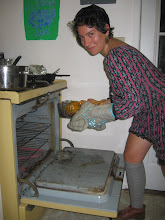My first summer home from college was when I started teaching myself how to can food. For my mom’s birthday that spring I had got her two books on canning, The Ball Complete Book of Home Canning and The Joy of Pickling, with the intention that we could both learn how to can together when I came home. Somehow, however, I’ve been the only one to really use the books; Mom just didn’t have the same drive to can, I guess. One thing that I really enjoy about both books is that they have so many recipes for things I would never think of and that tantalize my taste buds just reading. And that there can be so many different variations on things. For instance, pickled eggplant. The Joy of Pickling has five different pickled eggplant recipes, three of which come from different countries in the Mediterranean. They all sound good, so I decided to try two of them; one to save for the winter and one that would be ready to eat within a week.
Pickled Eggplant Cubes
Makes 3 pints



3 cups white wine vinegar
2 ¼ lbs eggplants (2 good sized ones may weigh a little more, but that’s what I went with), peeled an cut into 3/8- to 1/2-inch cubes
2 tablespoons chopped garlic
¼ cup loosely packed small basil leaves (I love basil and I had a lot, so I probably used at least ½ cup)
2 teaspoons pickling salt
- Sterilize your jars.
- Bring the vinegar to a boil in a nonreactive saucepan. In 3 or 4 batches, blanch the eggplant in the vinegar for 2 minutes. Transfer the eggplant to a bowl with a slotted spoon.

Lebanese Pickled Eggplant Stuffed with Garlic

1 ¼ lbs 3- to 4-inch long eggplants
1 garlic bulb, separated into cloves, the cloves peeled and crushed
1 tablespoon plus 1 teaspoon pickling salt
½ teaspoon cayenne
1 ½ cups red wine vinegar
¾ cup water


1. Sterilize 1 quart jar.
2. Steam the eggplants 5-7 minutes, or until they are tender but not mushy. Let them cool.
3. Slit each eggplant once lengthwise, cutting most of the way through. Mix the garlic with the 1 tablespoon salt and the cayenne, and stuff the eggplants with this mixture. Pack the eggplants into a sterile 1-quart jar.

Little burgers!
4. In a nonreactive saucepan, bring to a boil the vinegar, water, and remaining 1 teaspoon salt, stirring to dissolve the salt. Let the liquid cool.
5. Fill the jar to the brim with the cooked liquid (top the jar off with a little more vinegar, if necessary). Cover the jar with a nonreactive cap. Let the jar stand in a cool place for 1-2 weeks.
6. If you don’t eat the pickles right away, store the jar in the refrigerator. The pickles will keep for at least several weeks.
Just sampled my first one of these a minute ago and it was goood. Not too strong on the vinegar at all, so maybe I'd try doing a 2:1 vinegar to water ratio for the eggplant cubes next time.











